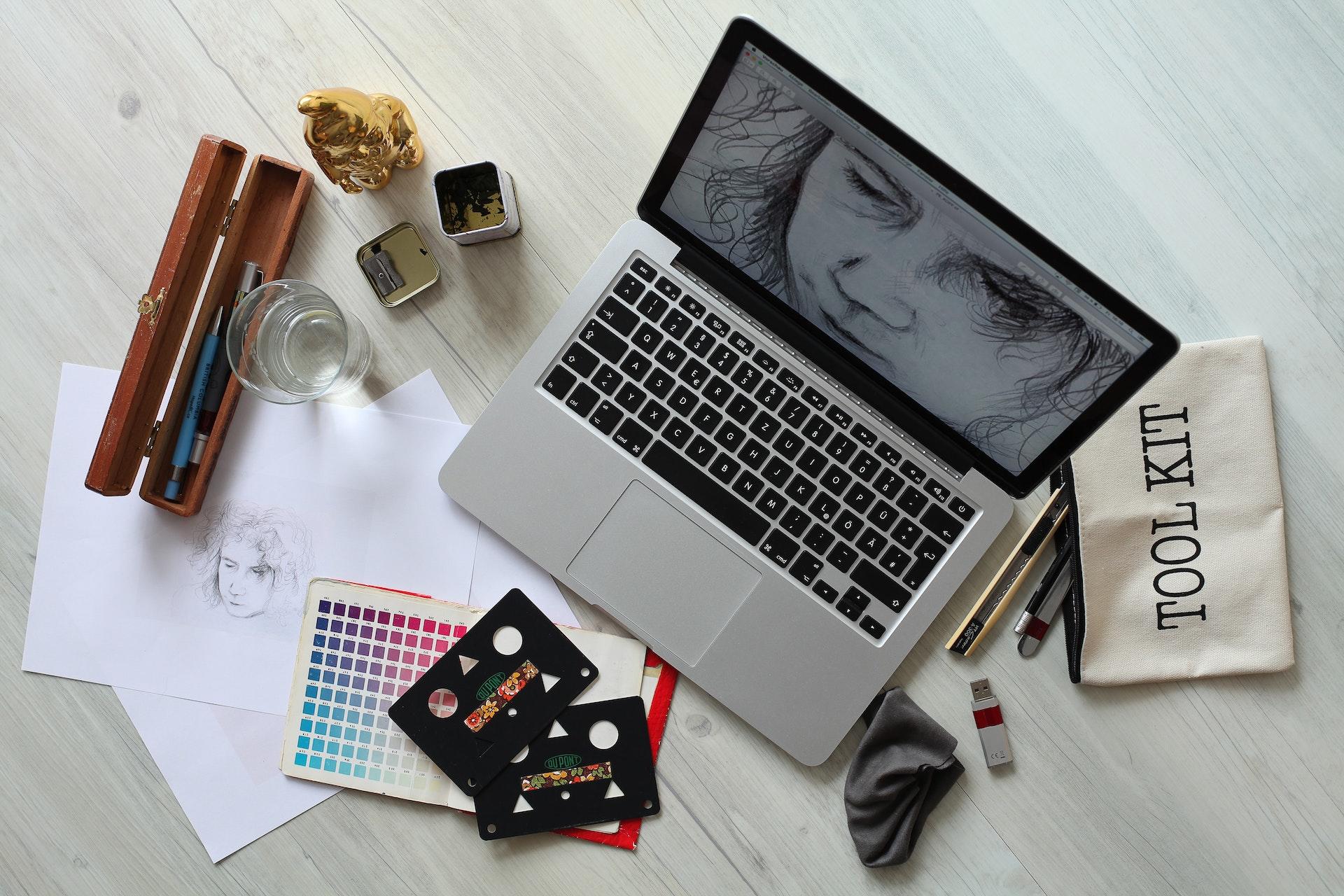In the realm of art, there are so many different mediums and techniques to explore. Many artists take skills they develop in one medium and apply them to totally different ones to create innovative and distinct artistic styles.
So, whether you are already familiar with 2D and/or 3D art and wondering if they share similarities or aren’t sure which one to start with, check out this guide to the different dimensions (in drawing).

2D Art Fundamentals in Drawing
Let’s start with the art form that people are usually introduced to first. Since it’s typically easier to teach and less expensive than some materials needed for 3D art, the majority of people are taught some of the basics of 2D art throughout their school years.
Crayons and colored pencils on computer paper are some of the first bits of exposure we get to the world of art. From there, we progress on as our motor skills improve and we can understand more concepts.
Let’s go over the elements that generally make up the 2D art world.
Mediums
Just like 3D art (which we will get into), 2D art can utilize different mediums.
As long as texture doesn’t play too large a role in the piece, you can make 2D art out of an enormous swath of different materials.
Typically, people will use things like pencils, charcoal, ink, markers, chalk, and paint (watercolors, acrylics, gouache, oils, spray, etc.). Sometimes, artists even use natural pigments like extracts from plants, coffee, dirt, or even blood to achieve their desired look.
Other 2D mediums include photography, paper or fabric prints, stained glass, and collage.
In the digital realm, 2D art can be made in a variety of digital art programs, like Photoshop, Procreate, and dozens of others.
Techniques
In order to achieve your vision when working with 2D, you need to know how to convey what you’re thinking onto your canvas, which is a much different process than when you’re working in 3D. These techniques apply whether you’re working with a physical or digital canvas.
Sighting: A handy way to measure proportion, especially when drawing still life, is using your pencil to “sight” or measure your references. You can compare heights, widths, proportions, and relationships between elements in your drawing.
Perspective: When putting everything down in a 2D space, you can’t adjust the camera angle afterward, and you can’t build an actual 3D image to ensure that the physics work themselves out. So, you need to know how to accurately portray things from the perspective you want them to be at, like one, two, or three-point perspective.
Technical Styles: Similar to perspective, technical drawings require precision to be made by you, the drawer, rather than software. Whether you’re portraying something in an isometric view, a cabinet view, or a Cavalier view, you need to know how to achieve the right results by hand.
Proportions and Gesture Drawing: For drawing humans and animals, you must be able to capture the pose, movement, and emotion you want in a static drawing. In many 3D programs, you can make a scale model, pose it how you like, and then change the camera angle to show the proportions and perspective as it would appear in real life. With 2D, figuring out how to forshorten and elongate, place shadows and highlights, and determine a realistic pose is entirely up to you and your talent.

The Basics of Drawing 3D Art
There are several different ways to think of 3D art: physical drawing, physical 3D designs, and computer or digital art.
In high school, I took a class called “3D Design,” and in the first week, many students tried to switch to a different class because it wasn’t what they thought. It was a class where we mostly cut up chipboard and used rubber cement to make it into things like masks and model houses, but some students thought it meant using computers to make 3D digital art.
This was back in the early 2010s, so things have changed and people probably understand the different terminology a little better now, but the moral of the story is: make sure you know what you’re getting into if you have a doubt about it!
Some techniques in 3D art apply to both physical and digital mediums, and some techniques apply to only one or the other.
Mediums
As I mentioned before, there are many different mediums for 3D art.
Physically, you can think of sculpture with marble, metal, papier-mache, wire, ceramics, pottery, cardboard, cloth, wood, and anything else you can sculpt (even butter) or make into a 3D shape.
Some flat canvas art can even have a 3D element like thick paint or added 3D objects that take it from the 2nd dimension into the 3rd.
In digital 3D art, you’ll likely use programs that actually have you creating models and arranging them in digital space. Like digital sculptures and dioramas. If you draw something in a computer program that only looks 3D because of shading, it’s still a 2D form. But if you create something in a 3D program and then take a still of it, even if it looks the same as your drawing, you can consider that to be 3D art (unless you, the artist, don’t want to… it’s a fine line!).
Many people create 3D art in programs and are only able to share stills of it, making it appear like 2D art. Unless your art is also an animation or a video game, something that can convey its 3D-ness to viewers, it might look just like 2D art to the untrained eye.
Techniques
How you approach making art in 3D differs from 2D.
In 3D, you’re creating a model that either looks right from a certain angle, or from every angle. If the way you’re going to showcase your art is with a still, the back of your character or scene doesn’t really matter. But if you’re making a marble statue or a video game character, every facet of your work needs to make sense.
Most 3D programs will have some pre-made models for you to use as a starting point or in conjunction with your work from scratch. You create wireframes and models of your characters, environments, and designs. It’s a technical process that requires quite a bit of computer know-how to be able to make things successfully with minimal frustration.


Commonalities Between 2D and 3D Drawing Art
There are, however, many similarities between these two types of art. In any instance, you are likely on a quest to create a good design, which requires knowing and following the fundamentals of art.
Color Theory
Both mediums require knowledge of color theory and light and shadow. Knowing how to use color to achieve the desired look and effect in any art piece is crucial. Successful color theory can make all the difference and take a piece from looking alright to being absolutely incredible.
Elements of Art
You should also be familiar with the basic elements of art: line, shape, color, value, form, texture, and space.
In 2D art, it might be more obvious how to approach these elements. You have more leeway in 3D art, especially if you’re making a piece, not a composition. But, you can still be aware of these elements and ensure that, if and when they do become relevant, you’re following good artistic practices.
Composition
Knowing the different types of composition is important no matter what type of art you’re working with. In 2D, you have one composition to worry about. When you make 3D art, you have to consider the composition of your work from the many different angles people might view it from.
Consider a marble sculpture, something you might see in the Met or the Louvre. While there is one main way to view the sculpture (from the front), the artist also had to consider: what if someone looked at this from the side or back, or peered up from below?
Creating visually appealing and interesting compositions from different angles in the same piece is challenging and a sign of a thoughtful and great artist.
There are many, many different kinds of compositions with some of the most popular being:
- Gestalt
- Figure-Ground Relationship
- Rule of Thirds
- Dynamic Symmetry
- Golden Mean and Fibonacci Numbers
Principles
Never forget your design principles: Balance, contrast, emphasis, movement, pattern, rhythm, and unity. In just about anything you can make with a visual element, you’ll need to consider these concepts to make sure your design is visually coherent and successful.
Do You Need to Know 2D Art to Start 3D Art?
In short: nope!
It doesn’t matter which medium you learn first (and you don’t even need to learn the other if you don’t want to). Some people are naturally more adept at one than the other, some people enjoy one more than the other, and some people like working with both equally.
While you need to be familiar with the basics of art and composition for both, the process between 2D art and 3D art is different enough that you don’t have to rely on your skill with one to transfer to the other.
Many people find 3D art easier because it’s more hands-on and many of the 3D mediums are more malleable than 2D. In 2D, if you mess up, you have to erase, redraw, and repeat, tweaking this and that until you get it right.
In many 3D mediums, especially digital, you can usually just move whatever it is that needs moving. It might take some adjustments here and there to get it right, but you don’t have to do the tedious task of erase, redraw, erase, redraw.
The 3D aspect also appeals to many because it’s how our world really is, which makes it easier for some brains to comprehend.

Choosing the Right Class for You
Ready to learn to draw 3D art?
Whether you want to start by taking 2D art lessons or hopping right into 3D, there are many places you can seek out instruction to begin your artistic endeavors.
In-Person Classes
If you attend a technical or art school where you can learn these skills, you’ll likely attend in-person classes. In-person classes can be beneficial because you share a space with other learners and foster a sense of unity. You may also have access to materials that would otherwise be up to you to purchase, like an easel or a computer with the software you need.
Online Classes
It’s entirely possible to learn from home, as well!
Typically, an online class would be part of a college or tech program, or a class that you signed up for independent of higher education.
The pros are that you can work from wherever you’d like and even “meet” students from near and far in the course common spaces. The cons are that you may be responsible for purchasing every bit of equipment you’ll need, including software (but you might be eligible for a student discount).
Video Tutorials
With the most budget-friendly approach, you can simply use YouTube University to learn all about the different techniques in 2D or 3D art! The downside is that you can’t ask questions in real time and get clarification. You might get lucky by leaving a comment, but you can’t rely on the kindness of strangers.
Private Instruction
While perhaps more costly, you can be certain that you’ll progress exponentially faster with private drawing lessons. With a tutor, you can learn all the basics of art and design, plus the specifics you’re interested in, with individualized attention.
Whichever type of drawing or design you’re attracted to, you’re sure to learn a lot and be able to unleash your creativity!















